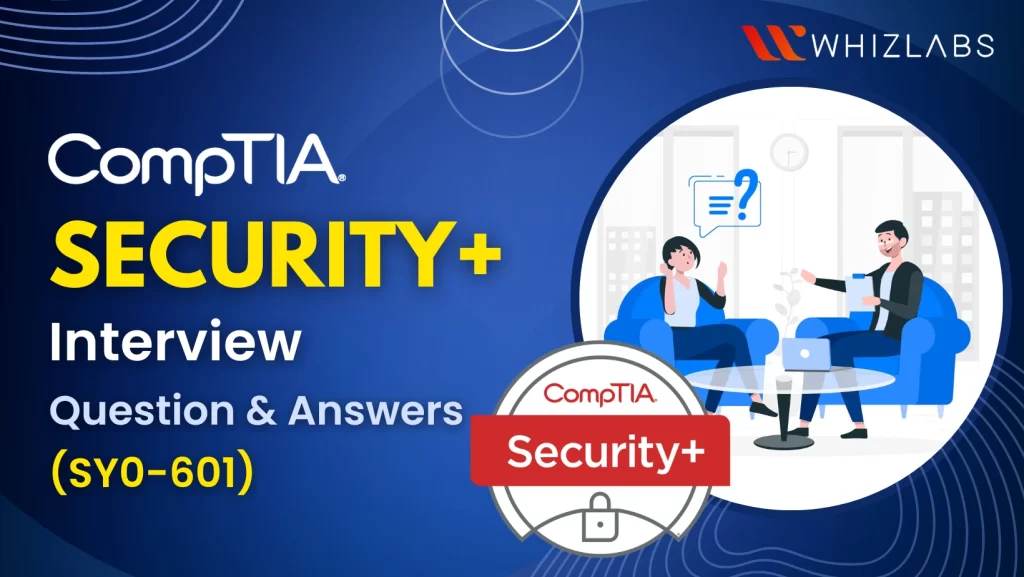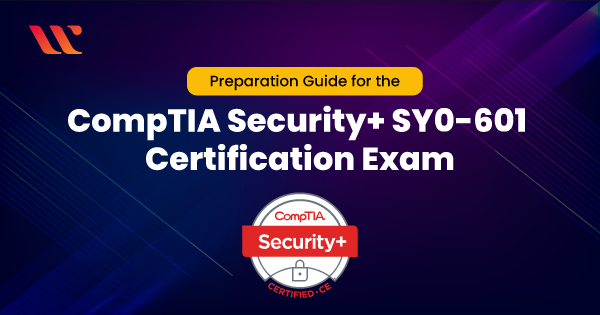CompTIA Security+ (SY0-601) certification is a great way to become an IT security professional. Preparing for a CompTIA Security+ (SY0-601) interview requires a solid grasp of information security fundamentals.
CompTIA Security+ (SY0-601) certification helps to demonstrate your expertise in areas such as implementing robust authentication, vulnerability management, and device security. Moreover, a strong foundation in network security, compliance, and operational security is also crucial.
To help you excel in your CompTIA Security+ interview, we have compiled a comprehensive list of the most common interview questions you can expect. By familiarizing yourself with these questions and their answers, you’ll gain the confidence to showcase your knowledge and skills.
To clear the CompTIA Security+ (SY0-601) exam, you must go through the CompTIA Security+ sy0-601 syllabus, practice exams, and books continuously.
Let’s dig in!
Top 20 Comptia security+ Interview Question and Answers (SY0-601)
Also Read: Preparation Guide for CompTIA Security+ Certification Exam
1. What is Cross-Site Scripting (XSS) and explain how to defend against it?
A security vulnerability known as cross-site scripting (XSS) happens when a website permits malicious code injection into its pages, generally due to user input or insufficient data validation. This code can hijack user sessions or steal confidential data like passwords.
Sanitizing all user input and output will help you defend against XSS attacks by preventing the insertion of malicious code. You may also use Content Security Policy (CSP) headers to limit the sources from which a page may load scripts.
2. What is meant by “Gateway”?
An important point of interaction between two networks that enables data transmission will be termed a gateway. It provides a bridge for data transfer between two networks by acting as an entry and exit point. The internet would not function without gateways.
3. What is the significance of Port 443?
A virtual port called port 443 is used to reroute network data. Its main objective is to make HTTPS (Hypertext Transfer Protocol Secure) based online communication more secure. In order to transfer encrypted data securely between a web server and an end user over the internet, web servers frequently use port 443 to prevent unauthorized individuals from intercepting the data.
4. Can you describe the three essential components of a security framework?
The Cybersecurity Framework consists of the following three basic components:
- Core: It is a collection of cybersecurity actions and results that are explained in a single language.
- Tiers of Implementation: They give us context for how an organization sees cybersecurity risk management.
- Framework profiles: They can be used to link an organization’s specific needs, goals, risk tolerance, and resources to the desired results.
5. Why is business impact analysis important in CompTIA Security+ (SY0-601)?
In essence, the Business Impact Analysis (BIA) assists us in identifying critical business processes and can forecast the outcomes of interruption of one of those processes. Additionally, it aids in the collection of crucial data that we need to create recovery plans and reduce possible losses.
6. What does an application security evaluation seek to accomplish?
An application is subjected to a security evaluation to check for potential vulnerabilities and offers solutions. The application development process can be improved by looking at the underlying reasons for the problems.
7. What are the challenges in the security of embedded systems?
A variety of security challenges are posed by embedded systems. Due to processor speed and memory constraints, it is challenging to load the software needed to execute cybersecurity. Additionally, creating the system to fend off attacks necessitates a thorough understanding of how to develop hardware that enables robust cybersecurity as well as safe software.
8. What do you mean by security threats, vulnerabilities, and risks?
A vulnerability is a flaw in the hardware, software, or operating methods of your system. A vulnerability exposes your company assets to risks. A harmful occurrence that causes a vulnerability can be termed a threat. The possibility of harm or loss, when the danger emerges, will be termed as risk.
9. What is meant by Strategic Threat Intelligence?
Strategic Threat Intelligence provides information on cybersecurity, cyber threats, the financial implications of security incidents, attack trends, and their effect on business choices. This information’s goal is to help organizations manage their current cyber risks and get ready for potential threats in the future.
10. Is security on-premises better than security in the cloud?
A business that has its own on-site servers and stores its data there has better security control than one that does. On the other side, improper server management could put your business at risk for security breaches. On the other side, cloud service providers can help manage security infrastructure and safeguard their clients.
11. What is the difference between Authentication and Authorization?
Authentication refers to the process of verifying a user with the help of identity. However, authorization is the process of assuring what a user has access to. To illustrate these processes in the real world, think back to the last time you went through airport security. You showed your ID to the security officer in order to identify who you are.
12. What is meant by application attacks?
An instance of cybercrime where an unauthorized party enters restricted regions is known as an application attack. Cybercriminals frequently begin with the application layer before looking for flaws in the code.
13. What is meant by Cyber resilience?
Cyber resilience is the ability to be ready for, react to, and recover from a cyberattack. It helps an organization protect itself from online threats, reduce the likelihood of a cyberattack, and ensure that it will still exist in the event of one.
14. What is meant by NIST Framework for Cybersecurity?
The NIST framework consists of five unique functions. Each one denotes a set of obligations and demands that must be fulfilled. To create a holistic and all-encompassing cybersecurity plan, businesses must integrate these duties.
There are five pillars that make up the NIST framework and they are:
- Identify: Determine the types of dangers and all resources that might be in danger by identifying them.
- Protect: Consider how to most effectively protect all of the identified assets.
- Detect: Describe how assets’ hazards will be found.
- Respond: Explain the crucial steps to follow in the event that a threat is found.
- Recover: Determine how to fix and secure the damaged infrastructure as you recover.
15. What distinguishes SCADA and ICSS from each other?
Any technology used to direct and keep an eye on industrial processes is known as an industrial control system (ICS). A subset of ICS is supervisory control and data acquisition (SCADA) systems.
16. What are the cryptographic protocols are commonly used?
There are different encryption algorithms exist. The most commonly used are:
- DES Symmetric Encryption Algorithm
- 3DES Symmetric Encryption Algorithm
- AES Symmetric Encryption Algorithm
- RSA Asymmetric Encryption Algorithm
- ECC Asymmetric Encryption Algorithm
17. Define digital forensics.
A subfield of forensic science called “digital forensics” is dedicated to finding, obtaining, processing, evaluating, and documenting electronically stored material. Mostly all the illegal actions may be involved with the usage of electronic evidence, making digital forensics support significant for law enforcement inquiries.
18. What is meant by Social engineering?
Social engineering refers to methods used to convince a target to share particular details or carry out a particular action for questionable motives.
Cybercriminals can use social engineering attacks to deceive their targets by posing as someone else. They might pose as your boss, a vendor, a member of our IT staff, or your delivery service. No matter who they are pretending to be, their goal is always the same such as to obtain money or data.
19. Differentiate between Spim and spam.
Spam is a common term used for unwanted messages. Unwanted instant messages are referred to as spim. Spim can include viruses or spyware in addition to interfering with our messaging.
20. What are the most common categories of network attacks?
Some of the common categories of network attacks such as:
- Unauthorized access
- Distributed Denial of Service (DDoS) attacks
- Man in the middle attacks
- Code and SQL injection attacks
- Privilege escalation
- Insider threats
21. Why physical security control is significant?
The personnel, facilities, and assets are protected from external threats by means of physical security controls. The dangers may be caused by internal or foreign intruders who raise concerns about data security. Physical assaults can result in the intrusion into a restricted area or the breaching of a safer data.
22. What are the primary steps involved in risk analysis?
The Risk Assessment consists of the following important steps:
- Finding the hazards
- Analysis of cause and effect
- Risk evaluation and implementing actions
- Recording the results
- Review risk assessment
23. What advantages does the information life cycle offer?
Entities can control the roles, duties, and obligations of every piece of data from the time it is created until the time it is destroyed by using information lifecycle management. Policies and procedures pertaining to data privacy probably need to be updated, and they must work well with other pertinent policies.
24. What are the five important risk management strategies?
The following are the five risk management techniques:
- Using a risk-based approach
- Taking risks under control
- Setting up procedures to address risk
- Periodically assessing hazards
- Disclosing hazards on an ongoing basis
25. What principal forms of control are there?
The Internal Control System is split into preventative and detective measures that assist prevent fraud. Strong internal control systems need both of these components.
Summary
Hope this blog offers CompTIA Security+ (SY0-601) exam interview questions and answers. By successfully passing the CompTIA Security+ (SY0-601) exam, you can enhance your resume and distinguish yourself from competitors. Begin your preparation today and set yourself up for success.
Obtaining the CompTIA Security+ certification will validate your expertise in the field of information security and open doors to exciting career opportunities.
Don’t wait any longer—start preparing now and pave the way for a promising future!
If you have any doubts about this blog post, please contact us now!
- Top 20 Questions To Prepare For Certified Kubernetes Administrator Exam - August 16, 2024
- 10 AWS Services to Master for the AWS Developer Associate Exam - August 14, 2024
- Exam Tips for AWS Machine Learning Specialty Certification - August 7, 2024
- Best 15+ AWS Developer Associate hands-on labs in 2024 - July 24, 2024
- Containers vs Virtual Machines: Differences You Should Know - June 24, 2024
- Databricks Launched World’s Most Capable Large Language Model (LLM) - April 26, 2024
- What are the storage options available in Microsoft Azure? - March 14, 2024
- User’s Guide to Getting Started with Google Kubernetes Engine - March 1, 2024


